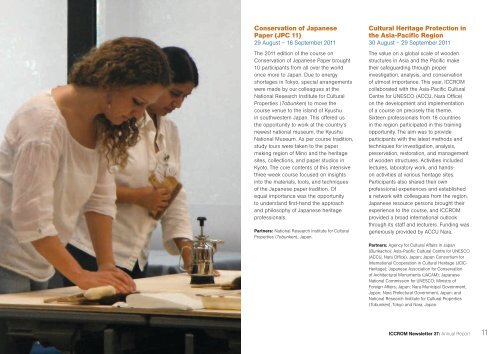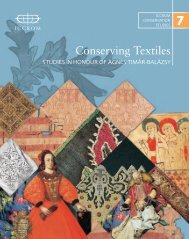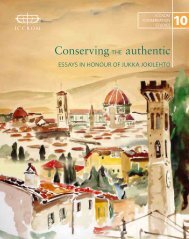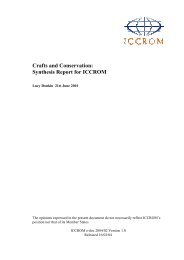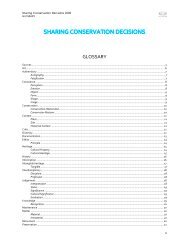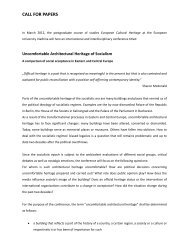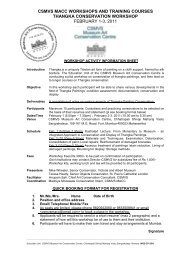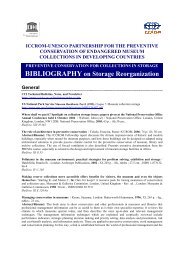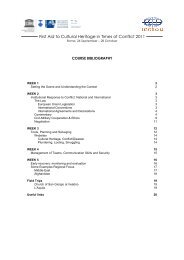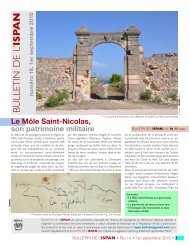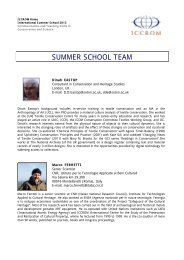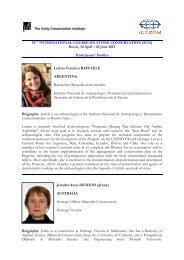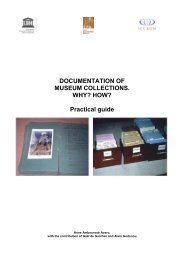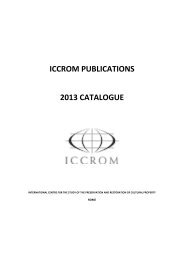Annual Report 2011 - Iccrom
Annual Report 2011 - Iccrom
Annual Report 2011 - Iccrom
Create successful ePaper yourself
Turn your PDF publications into a flip-book with our unique Google optimized e-Paper software.
Conservation of Japanese<br />
Paper (JPC 11)<br />
29 August – 16 September <strong>2011</strong><br />
The <strong>2011</strong> edition of the course on<br />
Conservation of Japanese Paper brought<br />
10 participants from all over the world<br />
once more to Japan. Due to energy<br />
shortages in Tokyo, special arrangements<br />
were made by our colleagues at the<br />
National Research Institute for Cultural<br />
Properties (Tobunken) to move the<br />
course venue to the island of Kyushu<br />
in southwestern Japan. This offered us<br />
the opportunity to work at the country’s<br />
newest national museum, the Kyushu<br />
National Museum. As per course tradition,<br />
study tours were taken to the paper<br />
making region of Mino and the heritage<br />
sites, collections, and paper studios in<br />
Kyoto. The core contents of this intensive<br />
three-week course focused on insights<br />
into the materials, tools, and techniques<br />
of the Japanese paper tradition. Of<br />
equal importance was the opportunity<br />
to understand first-hand the approach<br />
and philosophy of Japanese heritage<br />
professionals.<br />
Partners: National Research Institute for Cultural<br />
Properties (Tobunken), Japan.<br />
Cultural Heritage Protection in<br />
the Asia-Pacific Region<br />
30 August – 29 September <strong>2011</strong><br />
The value on a global scale of wooden<br />
structures in Asia and the Pacific make<br />
their safeguarding through proper<br />
investigation, analysis, and conservation<br />
of utmost importance. This year, ICCROM<br />
collaborated with the Asia-Pacific Cultural<br />
Centre for UNESCO (ACCU, Nara Office)<br />
on the development and implementation<br />
of a course on precisely this theme.<br />
Sixteen professionals from 16 countries<br />
in the region participated in this training<br />
opportunity. The aim was to provide<br />
participants with the latest methods and<br />
techniques for investigation, analysis,<br />
preservation, restoration, and management<br />
of wooden structures. Activities included<br />
lectures, laboratory work, and handson<br />
activities at various heritage sites.<br />
Participants also shared their own<br />
professional experiences and established<br />
a network with colleagues from the region.<br />
Japanese resource persons brought their<br />
experience to the course, and ICCROM<br />
provided a broad international outlook<br />
through its staff and lecturers. Funding was<br />
generously provided by ACCU Nara.<br />
Partners: Agency for Cultural Affairs in Japan<br />
(Bunkacho); Asia-Pacific Cultural Centre for UNESCO<br />
(ACCU, Nara Office), Japan; Japan Consortium for<br />
International Cooperation in Cultural Heritage (JCIC-<br />
Heritage); Japanese Association for Conservation<br />
of Architectural Monuments (JACAM); Japanese<br />
National Commission for UNESCO; Ministry of<br />
Foreign Affairs, Japan; Nara Municipal Government,<br />
Japan; Nara Prefectural Government, Japan; and<br />
National Research Institute for Cultural Properties<br />
(Tobunken), Tokyo and Nara, Japan.<br />
ICCROM Newsletter 37: <strong>Annual</strong> <strong>Report</strong> 11


